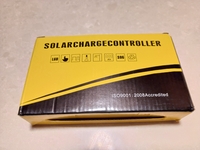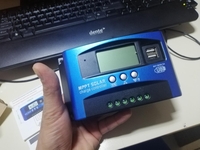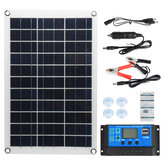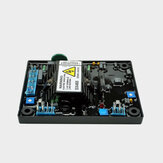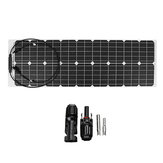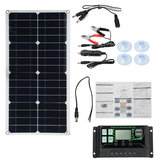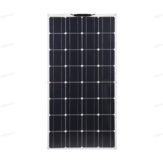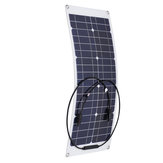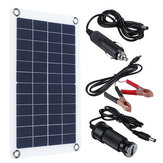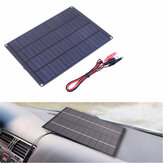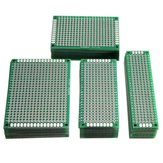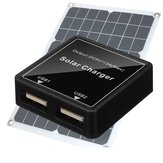Customer Reviews
- All Reviews (1164)
- Image (179)
- Video (0)
A part of the review has been auto-translated.
-
 aruginaVIP5RO04/12/2021
aruginaVIP5RO04/12/2021This is not a MPPT charger as other people have stated. it's a PWM, see attached pictures, has no coils or transformers inside to adapt impedance from the solar pannel to batteries. interesting itt has two barrel connectors that are not documented.
Comments (11)Show Original -
24/08/2021
Excellent product which I have purchased and used on previous occasions. The unit comes well packed for shipping and in it’s own box. In the box is the charge controller and a manual which gives installation and configuration instructions in English and Chinese. A diagram of the controller gives clear instructions on how the solar panel input, battery and load output are connected via paired (plus/minus) screw terminals. The controller can be configured via the display and selection buttons. The display is large enough to be read without glasses for most however it is not illuminated so will require an external light source to be read in a dark environment. The controller supports the display of battery voltage, solar panel charge current, load discharge current, accumulated discharge power and accumulated charging power. The controller supports the configuration of battery high voltage disconnection, low voltage disconnection, low voltage re-connection and a load working mode which allows the user to turn the output load off ‘x’ hours after sunset or run the load 24 hours a day. As far as battery types the controller is quite flexible as the high voltage disconnection and low voltage disconnection and fully configurable within the bounds of your system (that is 12 volts or 24 volts). The controller ordered was 100 amp model. The manual for this controller stipulates that it can charge 60 amp to the battery and 30 amp to the load at the same time which only adds up to 90 amps but I guess there must be some leeway for internal currents. Conveniently the controller comes with two USB outputs. These are low amperage outputs. One important thing to remember is to make sure you connect the battery to the controller before solar input and load output and make sure that the battery / batteries you are connecting are reasonably charged. The reason for this is that the controller will sense the battery voltage and set itself up for a 12 volt or 24 volt system.
Comments (9)Show Original -
 DomwilkoVIP3GB15/06/2020
DomwilkoVIP3GB15/06/2020Not tried it yet, but it looks to be just what I need. I'm surprised that they haven't posted a manual for this online. Hence the reason for posting a picture of it in my review. The manual doesn't mention the ports either side of the screw terminals. What are these ports? Are they alternative Solar Panel Input and Load Output ports? Can you use them instead of the screw terminals?
Comments (2)Show Original -
 VIP1IN05/10/2018
VIP1IN05/10/2018This product is NOT MPPT Solar Charge Controller but a PWM Solar charge controller. I have been cheated buy the wrong product description and showing this as MPPT Solar Charger Controller. There are many options this site and for lessar price for a PWM based Solar Charge Controller. Now looking for the options to return replace this product.
Comments (8)Show Original -
26/09/2021
good price for a standard solar controller, but this is not a MPPT controller.
CommentsShow Original -
 MudzimbaVIP4ZA02/06/2020
MudzimbaVIP4ZA02/06/2020good one as always . Thank you banggood and Buffalo logistics .I love Buffalo logistics they don't give any stress when dealing with my orders unlike DHL
CommentsShow Original -
 wolkan07VIP1TR11/01/2021
wolkan07VIP1TR11/01/2021I have n't tried it yet. I received it in 10 days. Turkey sells around 550 tl and the people who provide it buy it from abroad and sell it to us :) I say pay less from banggood. I'll write it down after I try it. I'll integrate four 160 v panels 2 100-a gel battery systems.
Comments (17)Show Original -
22/05/2020
I have used this Controller since two months in my little solar home System ( 50w polycrystalline panel, 12v 18 Ah AGM Battery) and today it woks fine. This device is only for lead acid battery (open, AGM, gel). In the Manual is not clear about “Bat 1, Bat2, Bat 3” but I believe that Bat 1 is OPEN, Bat 2 AGM, Bat 3 Gel. I set the controller in Bat 2 and it woks ok. The instructions are very very shorts but is easy to understand the basic functions. The material quality is very good. The controller include 2 usb 5 v load and have 2 extra connectors 12v in the button (not indicated in the manual). The left side is active in sun light hours, and the right side in the night. I don’t know if this device is a MPPT or not but since 2 months in my solar system it works efficient and correctly. I recommend it.
Comments (1)Show Original -
 RoddersVIP5ZA03/11/2020
RoddersVIP5ZA03/11/2020Excellent device. 1 screw missing see picture. Overall well made, good soldering job, mosfets insulated from the bottom metal plate. The two sockets at the bottom are alternatives for solar (left) and load (right) - convenient. Will test-drive the functionality in a couple of days.
CommentsShow Original -
28/03/2020
Hello, I have received my parcel since 24/03/2020. However, I am not assured until I control the maximum voltage that the regulator could withstand. To my surprise, as soon as the controller was connected, it burned down. My solar array connection is at 48 volts. This error is mainly due to me and not related to the seller. In the near future, I will make sure of this very important detail.
CommentsShow Original




